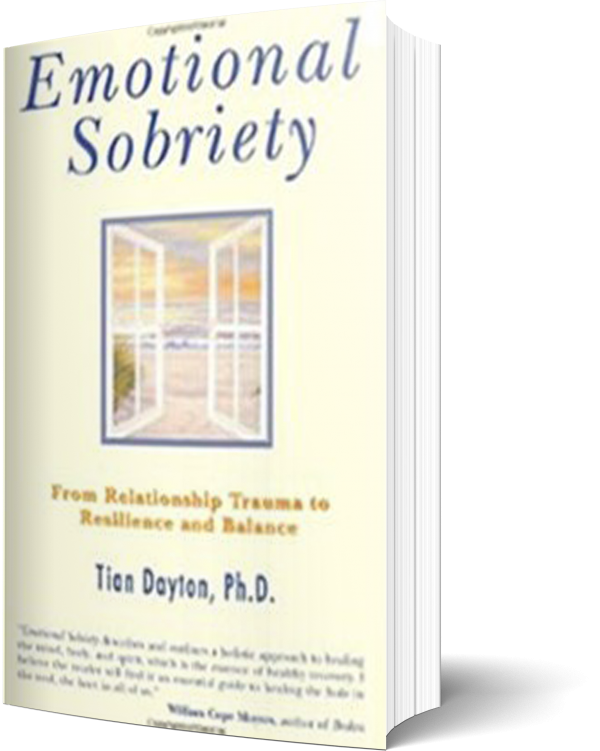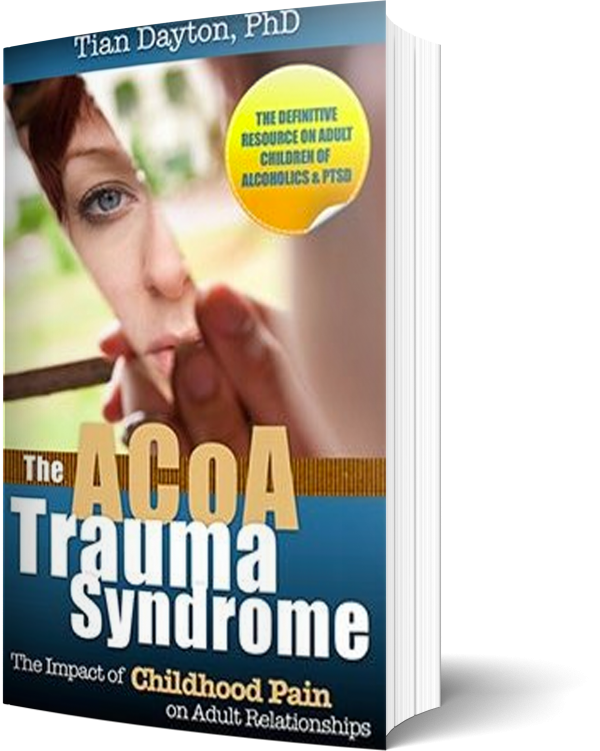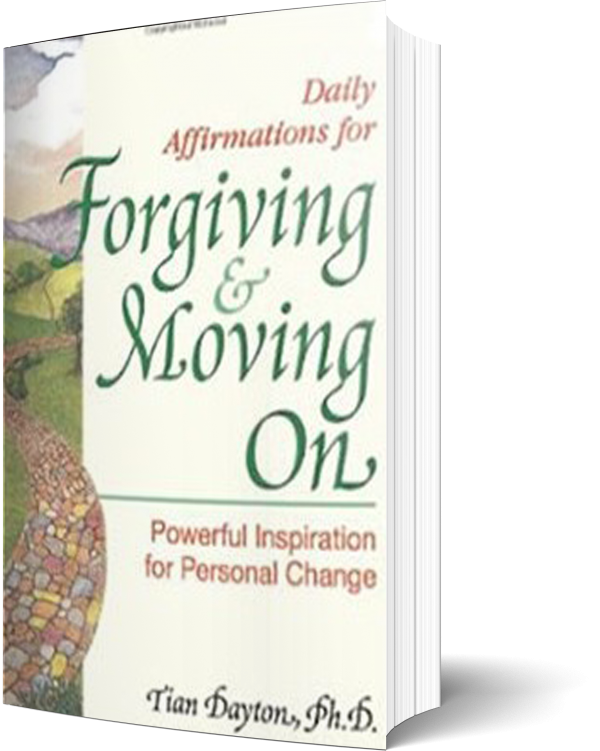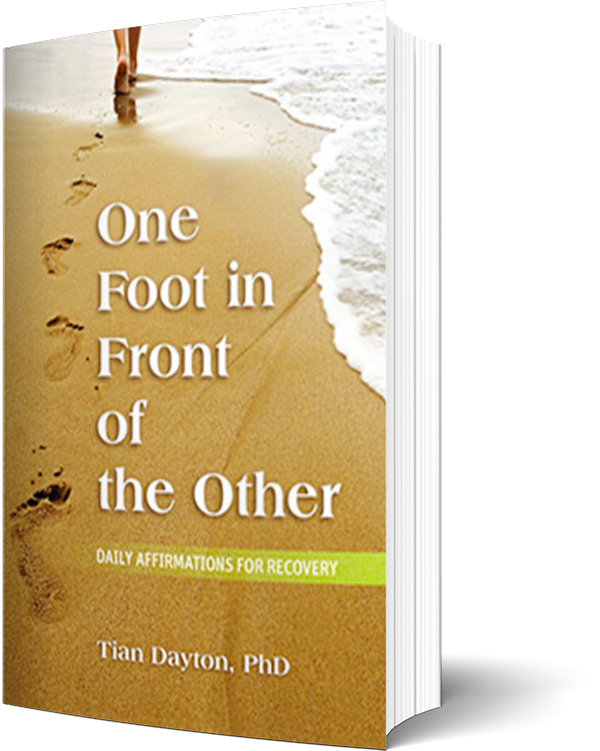Old pain that gets imported into new relationships is the hallmark of the ACoA trauma syndrome. The past we thought we’d neatly left behind once we got tall enough, old enough or smart enough intrudes onto our present and we are returned, in the blink of an eye, to childhood states of emotion and along with them floods of feelings and images that we “forgot” were there.
Confronted with an angry spouse, a critical boss or a tantrumy child, the ACoA may overreact to a present-day circumstance that somehow mirrors one from the past. Unaware that hidden childhood wounds may be causing us to react more intensely than is right-sized for what’s going on, we get caught in a mind/body combustion in which pain from the past is potentizing pain in the present. We get tight guts, we hold our breath and we wait “for the other shoe to drop.” We brace ourselves and wait for something bad to happen, just they way we did when we were kids. But we don’t know that’s what’s happening. Then we swing into defensive strategies, we explode or implode, we get aggressive and defensive or we disappear and withdraw. We stand at our full adult height, but on the inside, we’re that freaked out little kid all over again. In this manner pain from the past bleeds into the present. Seamlessly old hurt, anger and fear move from one generation to the next, because unresolved pain, anger and confusion don’t really disappear; they live within us, in a quivering silence that longs to make itself heard and known.
Where does it all begin?
Picture the child in the alcoholic home. There is a fundamental power imbalance. The child is small, the parent is big. The parent is the one who holds the keys to the house, the car, the refrigerator and the bank account. And everyone knows it. The parent has the authority. If a parent is yelling at a child, telling him that he is the problem, that if he would only change everything would be better, the child tends to believe him. Children look into their parent’s eyes to see a reflection of themselves, of who they are and whether or not they matter. When the parent is the one who is causing the stress, it’s a double whammy for the child. Not only is the child scared and hurt, but the person they would normally go to for comfort and solace is the one who is scaring and hurting them. They are disempowered by the very nature of their youth and dependency.
Kids are trapped in a world run and paid for by their parents.
If their parents are drunk or preoccupied with hiding ever-growing problems from themselves and the rest of the world, home can become a real pot boiler of emotions that are hard to untangle. The emphasis on the family moves from cooperation to hunkering down and staying safe. When the yelling comes, the child knows that if he fights back, he risks getting the family problems, that are running rampant through the house, focused onto him, or getting sent to his room, grounded, hit, punished or having his allowance taken away. Then he will be more trapped. So kids often take the path of least resistance: They comply, withdraw or shut down. Or they stand there and take it, but on the inside they flee, they dissociate, they disappear. Because the child is limited in their ability to access outside support, they have no one to tell them that they are after all not a terrible and troublemaking little person or to reassure them that everything will be all right and return to normal soon. Rather, they have to relay on their own, often immature ability to create meaning, but all too often, the meaning that they create casts themselves in a negative light. Their ability to understand, process and manage this situation is dictated by their very dependency and their limited intellectual equipment at any given point of development. The combination of these factors, the power imbalance, length of time spent in a dissociated state, the inability escape and their lack of mature, intellectual development, are factors that can contribute to childhood trauma having long impact. Years after the CoA has left home, they may carry anxieties about themselves and relationships that they do not fully understand. This is how the ACoA imports their past into their present. And because of the way the brain processes frightening or overwhelming experiences, none of this gets talked about. Or even thought about.
Our natural response when experiencing frightening or overwhelming situations is to self-protect. We do this by running away, retaliating in some way or, when neither are possible, by shutting down, by becoming “invisible”. FIght, flight, freeze. As children or adults these defensive strategies can result in our warding off or hiding from the very pain we need to face in order to remain aware of what is happening around us. If, when a frightening situation like being yelled at by a drunk parent occurs, we process it with someone who cares and make intellectual sense of it, we can return to normal or even learn a little something and be more resilient when problems come again. We get better at handling or avoiding them. But when this doesn’t happen, as is so often the case with stress and trauma in the home, that is being caused by parents erratic or irresponsible behavior, that pain goes underground, it sinks down inside, forming a little pool of unprocessed emotion that sits in our inner world. But out of sight is not out of mind. Unprocessed pain does not disappear; it lays dormant, waiting for some similar memory cue to return it to the surface waiting, in other words, to be remembered. Even loud voices, a raised eyebrow or a change in mood can send the ACoA sailing back into a place inside of them where they shiver inside and wait, just as they did as kids, for something bad to happen.
When We’re Very, Very Scared…
The thinking, or language part of the brain shuts down so that the human organism has no interference in it’s powerful urge to either fight and defend itself or flee from danger. Therefore, it’s our most frightening experiences that often times don’t get translated into words, thought about and put into a context. They live instead within us as fragmented and un-integrated “pieces” of personal experience, they dance on the edges of our conscious awareness or they lay below the surface, submerged in the deep waters of our unconscious. Even loving and well-meaning parents can be frightening to a small child who is tracing every movement of their face for signs of anger. Kids are so small vis a vis their parents, so subject to the mood of the household and the state of mind of those in charge of their young lives. Add parental alcohol or drug abuse, depression or anxiety to this family equation and you have a potent cocktail for kids feeling scared and even traumatized by what’s going on in the home.
Some of the factors that sear trauma in place and make it more likely that a child of addiction (or family dysfunction) will develop PTSD are:
• Whether or not escape is possible. Can the kids get away from stressful, painful family scenes?
• Whether or not there is a power imbalance (which of course, there is).
• Did the child have access to outside support? Were there caring, concerned adults who could provide “safe haven” or a place the child could feel, if only momentarily, out of harm’s way? A place that could provide a “reality check” or model a different way of being in a family?
• The length of time that the COA spends in a numbed out or dissociated state. Trauma in the home tends to be cumulative — it occurs incrementally and over a significant period of time.
• The developmental level of the child. How old were they when trauma in the home occurred and what age-related capacities did they have to make sense of confusing, painful or frightening experiences?
• Whether or not it’s the parents, who they would normally go to for comfort and reassurance who are causing the stress?
These are some of the factors that give trauma in the home such traction. Intense feeling states get wired into kids, and rather than absorb skills of emotional calm and regulation from their homes they absorb states of emotional chaos and extremes. (You might say they get skilled at over- or under-reacting.) Then as adults when they are in the midst of intense emotions, which are after all simply a part of life and relationships for anyone, they have trouble keeping their emotional reactions right-sized. And often times they feel somehow defective in their reactions so they try to hide them and put on a false face to others and even to themselves.
But this sort of beginning need not be a life sentence. No one needs to feel alone or crazy because their past pain is leaking into their present. Twelve-step programs like alanon, CODA and ACOA meetings are filled to the brim with people “who know because they’ve been there” and will quietly nod their heads in recognition and identification as these stories unfold and are told. Twelve-step programs are essentially free and by their tradition are not connected with any sort of commercial enterprise. Many who enter “program” feel that they “no longer regret no wish to close the door on their past” because they have found such positive support and life direction by joining with others on a healing journey. The ACoA trauma syndrome, in other words, can as easily open a door to the soul as close it. As a member of my group recently said, “I saw you do your psychodrama tonight. I saw you struggle to let yourself feel, to let yourself say what you wanted to say. I saw you start to feel. It was like a door inside you opened up. I remembered that moment when I started group and had that feeling. When it came to me… when that door… I mean, I had been waiting so long for something to happen… when that door inside me opened and I finally realized… I saw… that the person who was holding it closed all along, was me.”
For more info click: http://emotionexplorer.com/acoa





